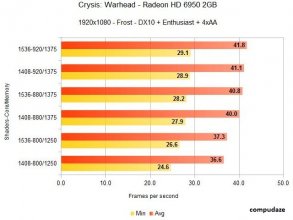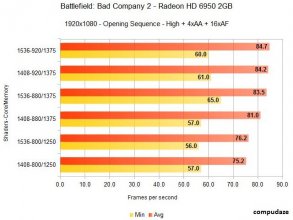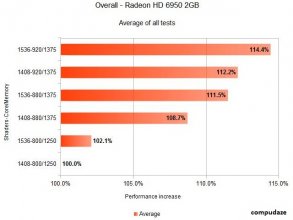Bitcoin 6950 performance
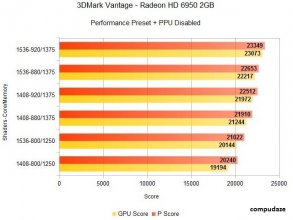 I've read way too many “which graphics card should I buy” threads and there's one recommendation that pops up a lot. It's that you should buy a Radeon HD 6950 and unlock the extra shaders to turn it into a Radeon HD 6970. With all the hype surrounding the Radeon HD 6950's unlocking ability, I wanted to find out how much of a difference unlocking the extra shaders really makes. So began my weekend of running benchmarks and compiling the results.AMD Radeon HD 6900 Series Specs
I've read way too many “which graphics card should I buy” threads and there's one recommendation that pops up a lot. It's that you should buy a Radeon HD 6950 and unlock the extra shaders to turn it into a Radeon HD 6970. With all the hype surrounding the Radeon HD 6950's unlocking ability, I wanted to find out how much of a difference unlocking the extra shaders really makes. So began my weekend of running benchmarks and compiling the results.AMD Radeon HD 6900 Series Specs
Here are the specs that matter for my tests:
Stock HD 6950
- Unified Shaders: 1408
- Core Clock: 800MHz
- Memory Clock: 1250MHz
- Unified Shaders: 1536
- Core Clock: 880MHz
- Memory Clock: 1375MHz
Test Setup
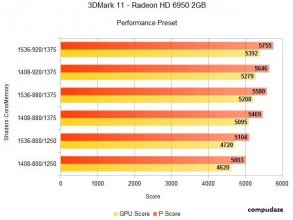 I'll be using my unlocked HD 6950 2GB to simulate a HD 6970. Everything that I have read suggests it should perform identically to a real HD 6970.
I'll be using my unlocked HD 6950 2GB to simulate a HD 6970. Everything that I have read suggests it should perform identically to a real HD 6970.
Below are the specs of my test system:
- CPU: Intel Core i5 2500K @ 4.8GHz
- Motherboard: Gigabyte P67A-UD3
- Hard Disk: OCZ Agility 2 (120GB)
- Memory: Corsair Vengeance DDR3-1600 2 x 4GB (8-9-8-24 1T)
- Video Card: Sapphire AMD Radeon HD 6950 2GB
- Video Drivers: Catalyst 11.2 (8.821-110126a-112962C-ATI)
- OS: Windows 7 Professional 64-bit
Unlocking the HD 6950 2GB
I'm not going to go into detail on how to unlock the HD 6950 as there are many threads on this subject already. Instead, I'm going to explain which method I used and why.
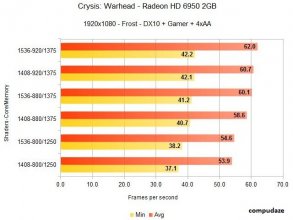 After reading several forum posts on many different sites I decided not to flash my HD 6950 using a HD 6970 bios. There seems to be a common agreement that problems could arise from using the HD 6970 bios as the memory voltage and timings are different. I don't have any data to back this claim up, but I still chose to go with the “safer” way of modifying my original bios to unlock the additional shaders. This method allowed me to keep the cards core speed, memory speed, timings & voltages totally stock while unlocking the additional shaders. Just a note, a friend of mine used the HD 6970 bios method and hasn't had any problems with it. Your mileage may vary.
After reading several forum posts on many different sites I decided not to flash my HD 6950 using a HD 6970 bios. There seems to be a common agreement that problems could arise from using the HD 6970 bios as the memory voltage and timings are different. I don't have any data to back this claim up, but I still chose to go with the “safer” way of modifying my original bios to unlock the additional shaders. This method allowed me to keep the cards core speed, memory speed, timings & voltages totally stock while unlocking the additional shaders. Just a note, a friend of mine used the HD 6970 bios method and hasn't had any problems with it. Your mileage may vary.
Overclocking
For my tests I also wanted to provide benchmarks for the max stable overclock I could reach on my particular card. Stable is a relative term and could mean different things for different people. It could also mean something different depending on your goal. For me, stable means rock-solid, 24/7 usage, stock-like stability.
I set out to find the max core and memory speeds I could use at the lowest voltage possible and remain 99.9999% stable. While I was able to boot at 980MHz core and run through several loops of Crysis, it wasn't stable. Sure, I could run Furmark for 24H at 950MHz, but it would crash after a few hours of real gaming. The best test I've found for stability is running the Crysis benchmark 99 times on the highest settings. If it can pass this, I'm totally satisfied.
